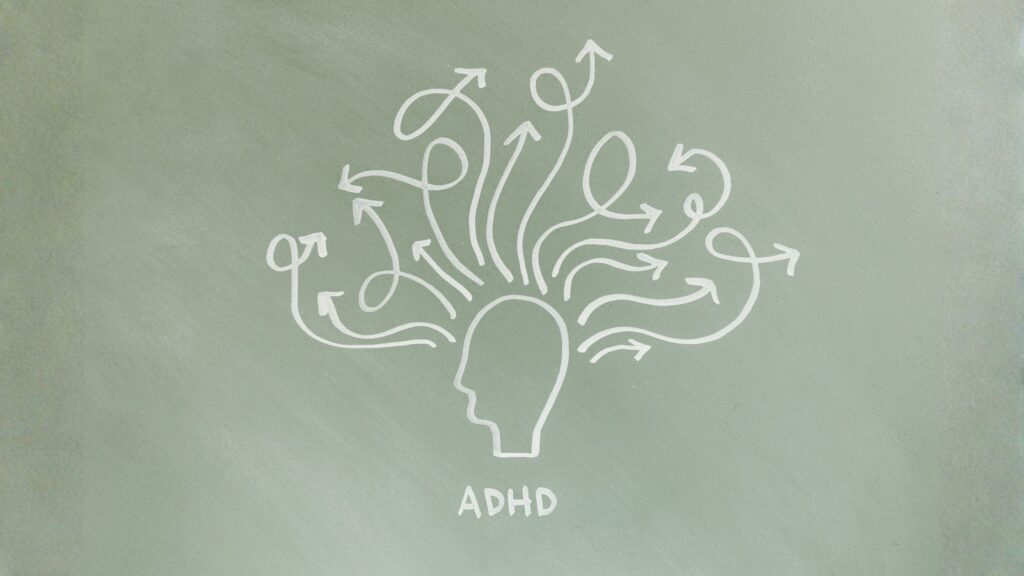For decades, attention-deficit/hyperactivity disorder (ADHD) was considered a condition that primarily affected boys—specifically, young boys who were impulsive, disruptive, and unable to sit still in class. This narrow view has left countless women undiagnosed, misunderstood, and struggling in silence. Today, research and clinical experience have begun to uncover what many women have known all along: ADHD doesn’t look the same in everyone.
In women, ADHD often appears in quieter, more internal ways—through chronic anxiety, perfectionism, emotional overwhelm, or constant mental exhaustion. Yet because of long-standing gender bias in research and diagnostic criteria, these signs are frequently overlooked or mistaken for something else.
Understanding why ADHD in women is so often missed—and what you can do about it—is the first step toward finding clarity and the right support.

How Gender Bias Shaped the Understanding of ADHD
ADHD was first recognized and studied in children during the mid-20th century, when most participants in research were boys. Early diagnostic models were built around symptoms typically observed in male children—hyperactivity, impulsivity, and disruptive behavior in school. These outwardly visible signs made ADHD easier to recognize in boys, while girls with the same condition, who often presented with more subtle, internalized symptoms, were largely ignored.
As a result, the diagnostic criteria developed from those early studies reflected a “male” version of ADHD. Clinicians were trained to look for fidgeting, blurting out answers, and trouble following classroom rules—not the daydreaming, disorganization, or emotional sensitivity more common in girls. This gender bias set the stage for decades of underdiagnosis among women and girls.
Even today, many healthcare providers rely on outdated understandings of ADHD. Women who don’t fit the stereotypical image of hyperactivity may be dismissed or misdiagnosed with anxiety, depression, or personality disorders instead.
What ADHD Looks Like in Women
ADHD in women often manifests differently than in men, and the symptoms can shift across life stages. For many women, signs of ADHD appear early but go unnoticed because they’re not disruptive—they’re simply overlooked.
Common ways ADHD shows up in women include:
- Inattention and distractibility: Difficulty staying focused, losing track of details, or feeling mentally “foggy.”
- Emotional sensitivity: Feeling easily overwhelmed or taking criticism to heart.
- Anxiety and overthinking: Constantly worrying about forgetting things, missing deadlines, or disappointing others.
- Perfectionism: Overcompensating for internal chaos by trying to control every detail.
- Chronic disorganization: Struggling to keep up with tasks, appointments, or routines—even with sincere effort.
- Low self-esteem: Internalizing years of frustration or the belief that you’re not “living up to your potential.”
Because these symptoms often don’t align with the stereotypical hyperactive behaviors associated with ADHD, women are more likely to be told they’re simply stressed, anxious, or “trying to do too much.” The truth is, many are living with a neurodevelopmental condition that affects executive functioning, attention regulation, and emotional control.
The Masking Effect: How Women Learn to Hide Their Symptoms
One of the biggest reasons ADHD in women is underdiagnosed is masking—the act of consciously or unconsciously hiding one’s symptoms to appear organized, competent, or calm.
From a young age, girls are often socialized to be well-behaved, attentive, and self-controlled. As a result, many girls with ADHD internalize their struggles instead of expressing them outwardly. Rather than being disruptive, they might sit quietly in class while their minds race or drift elsewhere. Teachers may describe them as “dreamy,” “shy,” or “hardworking but scattered,” without realizing these traits can signal inattentive-type ADHD.
As these girls grow into adults, masking can become a way of life. They may spend enormous energy keeping up appearances—staying late at work to make up for lost focus, creating endless to-do lists, or double-checking every detail to avoid mistakes. Over time, this constant self-monitoring can lead to burnout, anxiety, and exhaustion.
What looks like high-functioning success on the outside may, in reality, be a daily battle with focus, organization, and self-worth.
The Overlap Between ADHD, Anxiety, and Perfectionism
Many women with ADHD are first diagnosed with anxiety or depression, which are often secondary effects rather than the root cause. Living with undiagnosed ADHD means constantly navigating an unpredictable brain in a world that rewards consistency, order, and control. This can create chronic stress, which in turn fuels anxiety.
Perfectionism also plays a major role. Because ADHD can make follow-through and organization difficult, many women overcompensate by setting impossibly high standards for themselves. They work harder, stay later, and push themselves further to avoid feeling inadequate or being “found out.” This relentless drive to mask or fix perceived flaws can deepen emotional exhaustion and reinforce feelings of failure—even when they’re achieving a great deal.
In short, anxiety and perfectionism can act as both symptoms and camouflage for ADHD, making it even harder to identify the condition beneath the surface.
The Cost of a Missed ADHD Diagnosis
When ADHD in women goes undiagnosed or untreated, the consequences can be profound. Many women spend years blaming themselves for challenges that are neurological, not moral. The constant effort to stay organized or meet expectations can lead to burnout, relationship strain, and difficulties in school or work.
Some women internalize these struggles as personal failures, leading to low self-esteem or chronic self-doubt. Others may experience ongoing emotional dysregulation, impulsive decision-making, or financial and career instability. Without understanding the root cause, they may continue to treat symptoms—such as anxiety or depression—without addressing the underlying ADHD that drives them.
Getting the right diagnosis can be life-changing. It allows women to reframe their past experiences not as shortcomings but as signs of an unrecognized condition that deserves compassion and treatment.
ADHD in Women: Seeking an Accurate Diagnosis
If you suspect you might have ADHD, it’s important to seek evaluation from a clinician who understands how ADHD presents in women. An accurate diagnosis typically involves a thorough assessment that may include:
- A detailed clinical interview about current and past symptoms
- Input from family or school records (if available)
- Screening tools specific to adult ADHD
- Evaluation for overlapping conditions like anxiety or depression
Working with a provider who has experience diagnosing ADHD in women is key. They’ll understand how gender roles, social expectations, and internalized coping strategies can mask symptoms and lead to misdiagnosis.
Treatment and Support: What You Can Do About It
Once ADHD is properly identified, women have many effective treatment options. The best approach often involves a combination of strategies tailored to individual needs:
- Medication: Stimulant and non-stimulant medications can help regulate attention, impulse control, and energy levels.
- Therapy: Cognitive-behavioral therapy (CBT) and other evidence-based therapies can address emotional regulation, self-esteem, and executive functioning skills.
- Coaching and skills training: ADHD coaches help individuals develop personalized systems for organization, time management, and goal setting.
- Lifestyle adjustments: Regular exercise, structured routines, adequate sleep, and mindfulness practices can improve focus and reduce stress.
- Support networks: Connecting with others who share similar experiences can provide validation, community, and encouragement.
Treatment isn’t about “fixing” who you are—it’s about understanding how your brain works and finding tools that help you thrive.
ADHD in Women: Breaking the Stigma
Despite growing awareness, stigma still surrounds ADHD—especially for women. Many feel embarrassed to seek help or fear being dismissed as “lazy” or “overly emotional.” It’s crucial to remember that ADHD is a neurodevelopmental disorder, not a reflection of effort, character, or intelligence.
When women receive a proper diagnosis and appropriate support, they often experience a profound sense of relief. What once felt like constant failure finally makes sense. They can begin to rebuild self-esteem, communicate their needs, and embrace strategies that work with their brain rather than against it.
Take Action Today
If you’ve ever wondered whether your anxiety, perfectionism, or constant mental juggling could be signs of ADHD, you’re not alone—and you don’t have to navigate this process on your own. The Sterling Institute offers compassionate, evidence-based evaluation and treatment for ADHD in women, designed to help you understand your symptoms and regain control of your life.
Our office in Danbury, Connecticut welcomes patients for in-person appointments, and we also provide telehealth services for individuals in Connecticut, New York, and Florida. Our team will help you identify whether ADHD may be impacting your daily functioning and create a personalized treatment plan that supports your goals.
You deserve clarity, balance, and the tools to thrive. Reach out today to schedule a consultation and take the first step toward understanding and managing ADHD with confidence and care.

